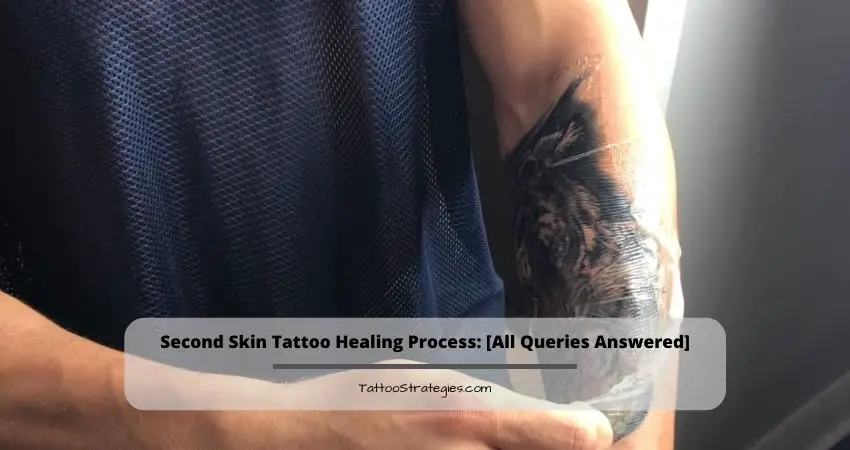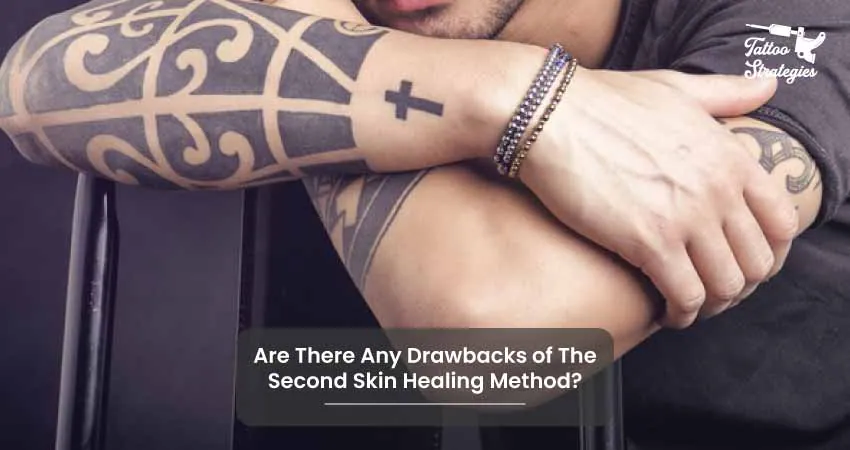Second Skin Tattoo Healing Process: [All Queries Answered]
You have heard about different healing methods after getting a tattoo. One of those popular methods is the second skin, which works wonders. You might want to know how the second skin tattoo healing process works.
Your new tattoo will be as secure as a second skin. This protective covering helps your body start the healing process while the injury is still exposed. It develops a thin layer of skin over your tattoo very quickly. This means that after you remove the second skin, a protective layer of skin will have developed organically over your tattoo.
If you want to know more about how to use the skin method and step-by-step guidance on it, follow this article.

Does Second Skin Work for Tattoo Healing?

Yes, it works well as an alternative method of tattoo healing. It’s a bandage designed to mimic the protective properties of the second layer of skin, shielding the underlying injury.
The concept was first put to use in helping people recover from serious burns, but it eventually gained fame as a means of keeping tattoos in great condition after they had healed.
Your tattoo will be protected from harmful bacteria and germs by the protective barrier provided by your second skin while healing. They eliminate excess moisture vapor, which may slow the healing process, and let oxygen into your tattoo.
How To Use A Second Skin for Tattoo Healing?

One of the reasons for the success of second skins is their simplicity of operation.
How to Apply Second Skin For Tattoo Healing At Home
- Remove any dirt or dust from your tattoo, then let it dry naturally.
- Cut the second skin to the appropriate dimensions with scissors so that it covers your tattoo. You have the option of making it somewhat larger to protect the flesh surrounding the tattoo at the same time.
- Take off the plastic covering to uncover the adhesive.
- Place it on top of your tattoo with the adhesive facing down, and apply little pressure.
- Check that it is firmly attached, and pop any air pockets that may have developed.
- To apply the tape, you need to remove the backing just as you would with plaster.
How To Remove Second Skin Once Your Tattoo Is Healed
- Take the bandage by one of its edges and carefully remove it. If it’s tough to get rid of, having a hot shower could help reduce the stickiness and make it easier to remove.
- As you peel off the outer layer, take your time. The process is quite like taking off a plaster. Pulling too hastily will cause pain. Another risk is that you’ll hurt the fresh skin below. You’ll be OK if you take it easy and move gently.
- After the bandage has been removed, be sure to give your tattoo a thorough cleaning and apply some lotion.
Read this article to know more about removing second skin from your tattoo.
How Long to The Keep Second Skin On A Tattoo?

You can keep the second skin as long as you’re comfortable. Most tattoo owners prefer keeping it for around 3-4 days.
However, you shouldn’t keep the same bandage on your tattoo for more than seven days before taking it off to clean it. While quite helpful, second skins can’t perform miracles. They don’t hold up as well in flexible regions as in rigid ones.
How to Deal With The Second Skin Healing Process: Step by Step Guide

Follow these steps to achieve maximum healing from the second skin method. There are a lot of factors that you need to keep in mind.
Day 1-3
Stay calm throughout the days. The plasma, blood, and ink will collect in certain regions of your bandage. It’ll have a gloomy, inky appearance. Those not acquainted with this kind of treatment may be alarmed by the appearance, but rest assured that it is quite normal.
Day 4-5
Stick with the original wrap or change to a new one, but don’t touch the bandage while the tattoo is healing. Don’t bother to pick at it, pull the skin off, or otherwise handle it. To put it simply, let things be. You may take a regular shower during this period, but you shouldn’t soak the bandage in water or get it too wet.
A tattoo may be damaged by germs that enter beneath a bandage if it is lifted, leaks excessively, or is exposed. If these things happen, you should remove the bandage and let the tattoo heal properly.
Day 6-7
Typically, tattoo artists advise clients to remove the healing wrap between days 6-7. The bandage will be simpler to remove off your skin if you remove it in the shower.
After the bandage has been removed, wash the tattoo with warm water and fragrance-free antibacterial soap to eradicate any lingering germs.
After rubbing it with paper towels, apply a light layer of fragrance-free lotion to your tattoo. Your tattoo should have a vivid appearance, with little flaking and no irritation.
Day 7+
Your tattoo may feel dry for another week or two after the bandage is removed, so use unscented lotion as required.
Avoid getting your tattoo wet or exposed to the sun for at least a few weeks after the bandage has been removed, even if it looks to be healed.
Why Should You Get a Second Skin for Healing Tattoos?

Having a protective barrier like a second skin in place can greatly reduce the possibility of contracting a disease. For a fresh tattoo, employing a second skin has several advantages. Here are some:
Waterproof
The fact that second skins are waterproof is a huge plus since exposure to water during the healing process may significantly slow the process down.
While you may take showers with your new tattoo intact, you should wait at least two weeks before submerging the inked region in a body of water. Be careful since submerging it in a large amount of water will reduce the adhesiveness of the second skin and reduce its effectiveness.
Breathable
Even when the tattoo is covered with a bandage, oxygen may still reach it via the second layer of skin. The healing process relies heavily on oxygen.
Protection Against Germs
Infection is more likely to occur in a fresh tattoo. A protective layer of skin may block off pathogens and keep you healthy.
Easy Healing
When using a second skin as a bandage, you may just let the tattoo alone heal. You may relax knowing that your tattoo is safe and will heal well.
Are There Any Drawbacks of The Second Skin Healing Method?

Unfortunately, yes. There are a few drawbacks to the process.
Potential Allergic Reaction
Most hypoallergenic second skins have a minimal chance of causing an allergic response in certain people. Extra caution should be used if you suffer from sensitive skin. Before applying it to a whole tattoo, it’s smart to try it on a tiny patch of skin first.
Cost
While using cling film comes with its own set of problems, it’s still less expensive than investing in a second skin. The benefits of having a second skin need to be weighed against the expenses. A cling film would cost around 4-5 dollars on Amazon, while a second skin would cost around 10 dollars or more than that.
Less Protection Against Leaks
If you don’t use it as prescribed, or if the skin bends a lot in that place, a second skin might leak. It’s recommended practice to inspect it often to avoid mishaps. However, if you’re trying to stay away from water, this may not be too much of a problem.
What To Do If The Second Skin Comes Off Early?

If the second skin peels off after a day or two, don’t reapply the tape; instead, focus on keeping your tattoo clean and hydrated. Do what you’re told to do: avoid wearing restrictive clothing, washing, and clean thoroughly, and use an aftercare balm. The risk of infection on a new tattoo increases when it is exposed.
Final words
I think by now, you should know about how the second skin tattoo healing process works. It works as a kind of protective bandage known as a second skin, intended to perform the same functions as an extra layer of skin to stop any more harm from occurring to an already damaged region.
